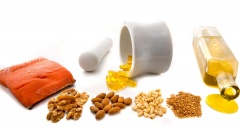Fatty Acids
| Infobox on Fatty Acids | |
|---|---|
| Example of Fatty Acids |  |
| Facts | |
| Origin | - |
| Stowage factor (in m3/t) | - |
| Humidity / moisture | - |
| Ventilation | - |
| Risk factors | See text |
Fatty Acids
Description
Derived from, or contained in an animal or vegetable fat or oil. Fatty acids may be saturated or unsaturated, and solid, semi-solid or liquid.
Fatty acids are acids produced when fats are broken down. They are considered “good fats.” These acids are not highly soluble in water, and they can be used for energy by most types of cells. They may be monounsaturated, polyunsaturated, or saturated. They are organic, or in other words, they contain both carbon and hydrogen molecules.
Fatty acids are found in oils and other fats that make up different foods. They are an important part of a healthy diet, because the body needs them for several purposes. Fatty acids help move oxygen through the bloodstream to all parts of the body. They aid cell membrane development, strength, and function, and they are necessary for strong organs and tissue.
Fatty acids can also help keep skin healthy, help prevent early aging, and may promote weight loss by helping the body process cholesterol. More importantly, they help rid the arteries of cholesterol build up. Another purpose of fatty acids is to assist the adrenal and thyroid glands, which may also help regulate weight.
There are different types of fatty acids such as Omega-3. Omega-3 is considered an “essential” fatty acid, as is Omega-6. There is one other, Omega-9, but this type can be readily produced by the body, while the other two types cannot.
In chemistry, and especially in biochemistry, a fatty acid is a carboxylic acid with a long aliphatic tail (chain), which is either saturated or unsaturated. Most naturally occurring fatty acids have a chain of an even number of carbon atoms, from 4 to 28. Fatty acids are usually derived from triglycerides or phospholipids. When they are not attached to other molecules, they are known as "free" fatty acids. Fatty acids are important sources of fuel because, when metabolized, they yield large quantities of ATP. Many cell types can use either glucose or fatty acids for this purpose. In particular, heart and skeletal muscle prefer fatty acids. The brain cannot use fatty acids as a source of fuel; it relies on glucose or ketone bodies.
Fatty acids that have carbon-carbon double bonds are known as unsaturated. Fatty acids without double bonds are known as saturated. They differ in length as well. Length of free fatty acid chains
Fatty acid chains differ by length, often categorized as short to very long.
- Short-chain fatty acids (SCFA) are fatty acids with aliphatic tails of fewer than six carbons (i.e. butyric acid).
- Medium-chain fatty acids (MCFA) are fatty acids with aliphatic tails of 6–12 carbons, which can form medium-chain triglycerides.
- Long-chain fatty acids (LCFA) are fatty acids with aliphatic tails 13 to 21 carbons.
- Very long chain fatty acids (VLCFA) are fatty acids with aliphatic tails longer than 22 carbons
Unsaturated fatty acids
Unsaturated fatty acids have one or more double bonds between carbon atoms. (Pairs of carbon atoms connected by double bonds can be saturated by adding hydrogen atoms to them, converting the double bonds to single bonds. Therefore, the double bonds are called unsaturated.)
Essential fatty acids
Fatty acids that are required by the human body but cannot be made in sufficient quantity from other substrates, and therefore must be obtained from food, are called essential fatty acids. There are two series of essential fatty acids: one has a double bond three carbon atoms removed from the methyl end; the other has a double bond six carbon atoms removed from the methyl end. Humans lack the ability to introduce double bonds in fatty acids beyond carbons 9 and 10, as counted from the carboxylic acid side. Two essential fatty acids are linoleic acid (LA) and alpha-linolenic acid (ALA). They are widely distributed in plant oils. The human body has a limited ability to convert ALA into the longer-chain n-3 fatty acids eicosapentaenoic acid (EPA) and docosahexaenoic acid (DHA), which can also be obtained from fish.
Saturated fatty acids
Saturated fatty acids are long-chain carboxylic acids that usually have between 12 and 24 carbon atoms and have no double bonds. Thus, saturated fatty acids are saturated with hydrogen (since double bonds reduce the number of hydrogens on each carbon). Because saturated fatty acids have only single bonds, each carbon atom within the chain has 2 hydrogen atoms (except for the omega carbon at the end that has 3 hydrogens).
See also Acids
Application
Used in the production of soaps, lubricants, paints and lacquers (drying oils), candles, salad oil, shortening, synthetic detergents, cosmetics, emulsifiers.
Shipment / Storage
Shipped in bulk or in metal drums.
Fatty acids are usually shipped in second-hand drums and tend to solidify in cold climates. In hot weather the acid will melt and expand causing pressure which may well burst drums. A clearance of 3 or 4 inches should be left between the surface of the acid and the lid of the drum to allow for expansion in hot weather. May be subject to loss in weight.
Distilled fatty acids, when coming into contact with metal such as iron, cause a corrosion which will affect the colour. This is a process of oxidation which can be controlled both chemically and physically. Ship’s tanks carrying such commodities should be submitted to a special treatment, e.g. coated with insulating material.
Risk factors
Keep containers tightly closed in a dry, cool and well-ventilated place. Keep away from direct sunlight. Do not store near or with any of the incompatible materials.
Consult the applicable handbooks and MSDS sheet.











